Abstract
The binding of dihydrostreptomycin to ribosomes and ribosomal subunits of a number of different Escherichia coli strains was studied, and the Mg2+ and pH dependence, as well as the effect of salts and polynucleotides, was determined. The only requirement for binding with ribosomes and subunits from susceptible strains was 10 mm Mg2+. Monovalent salts weakened the binding in a manner similar to the effects on ribonucleic acid secondary structure, and this was antagonized to some extent by increased amounts of Mg2+. Bound dihydrostreptomycin could be readily exchanged by streptomycin and any antibiotically active derivative, but not by fragments of the antibiotic or any other aminoglycoside. With native (run-off) 70S ribosomes from streptomycin-susceptible strains, the binding was rapid and relatively temperature independent over the range from 0 to 37 C. Polynucleotides did not stimulate the binding. With concentrations of dihydrostreptomycin up to 10−5m, greater than 95% of native 70S ribosomes bound exactly 1 molecule of the antibiotic tightly, with a Kdiss for the bound complex at 25 C of 9.4 × 10−8m. The following thermodynamic parameters were found for the binding with 70S ribosomes at 25 C:ΔG° = −9.6 kcal/mole, ΔH° = −6.2 kcal/mole, and ΔS° = +11.4 entropy units/mole. Differences in affinity for the antibiotic were found between ribosomes of K-12 strains and those of other E. coli strains. There was insignificant binding to 70S ribosomes or subunits from streptomycin-resistant or -dependent strains, and to 50S subunits from susceptible strains. The binding to 30S subunits from susceptible strains was weaker by an order of magnitude than that to the 70S particle, with a Kdiss at 25 C of 10−6m. Polyuridylic acid stimulated this binding slightly but did not influence the affinity of the bound molecule. At antibiotic concentrations above 10−5m, streptomycin-susceptible 70S and 30S particles bound additional molecules of the antibiotic, and binding also occurred to ribosomes from streptomycin-resistant and -dependent strains, as well as to 50S subunits from all strains. Kdiss for all of these binding equilibria were [Formula: see text] 10−4m. This weaker non-specific binding coincided with the beginning of aggregation phenomena involving the particles, and occurred at sites distinct from the single site which binds the antibiotic tightly. This latter site was completely lost after the one-step mutation to high-level resistance or dependence.
Full text
PDF
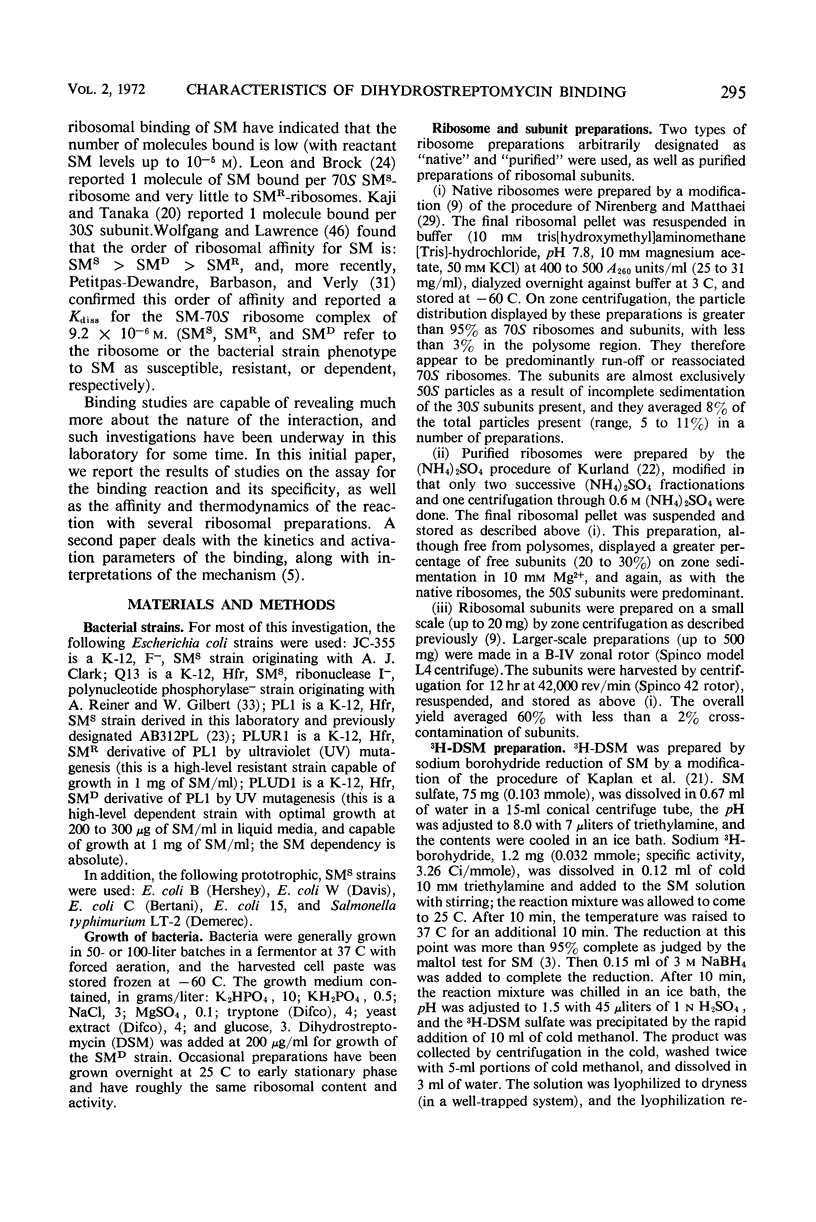
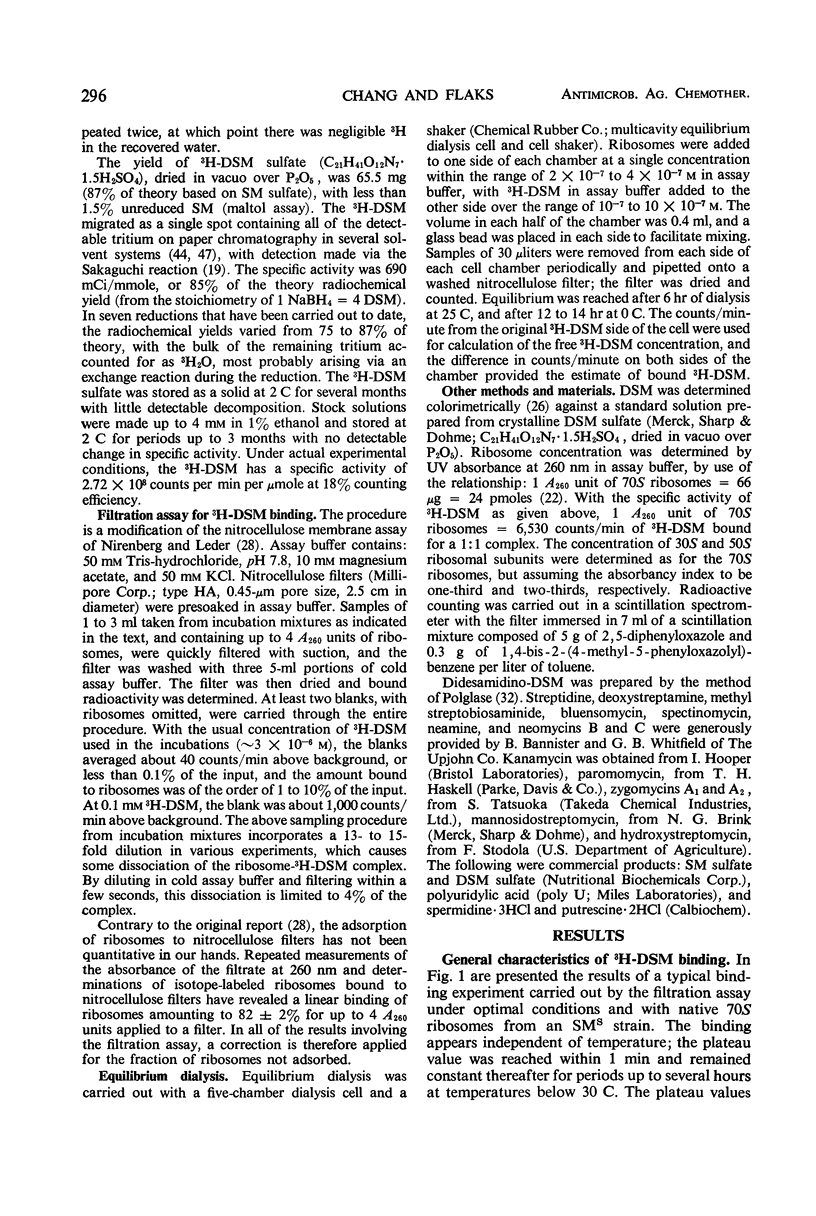
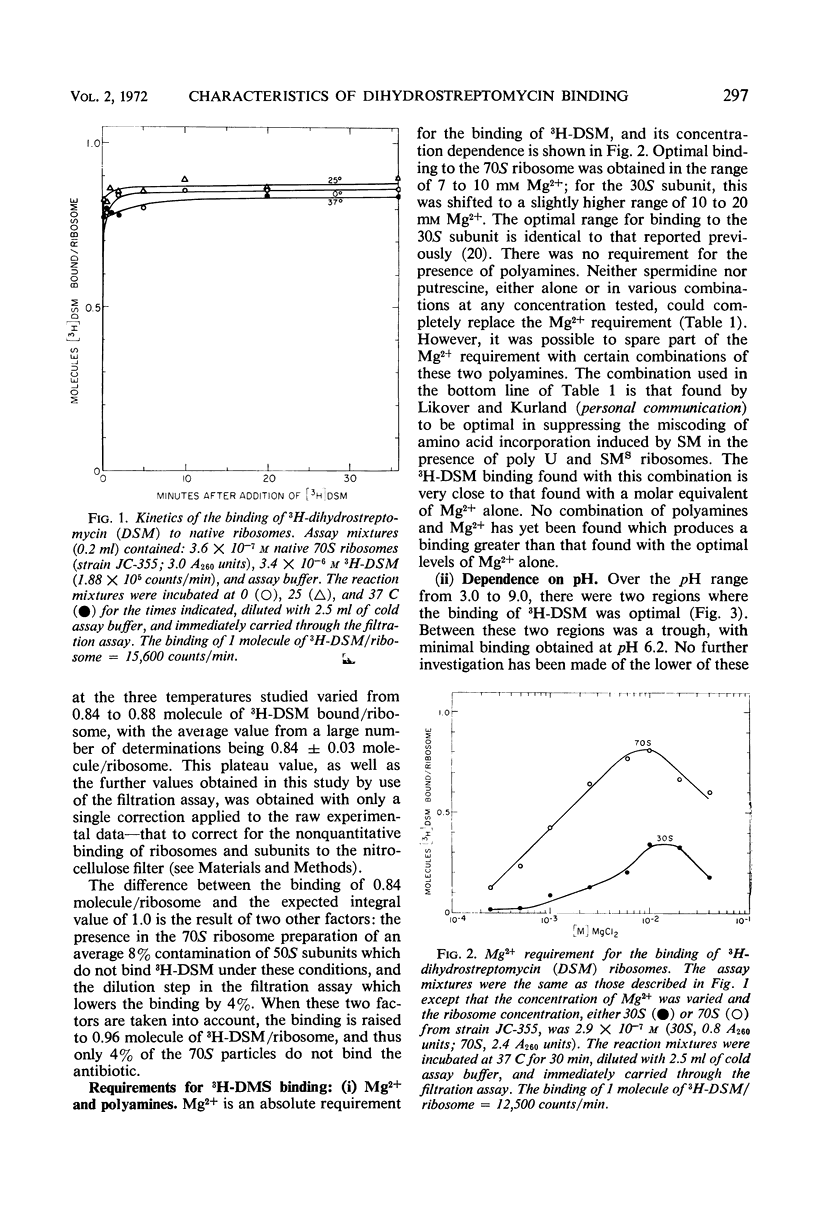





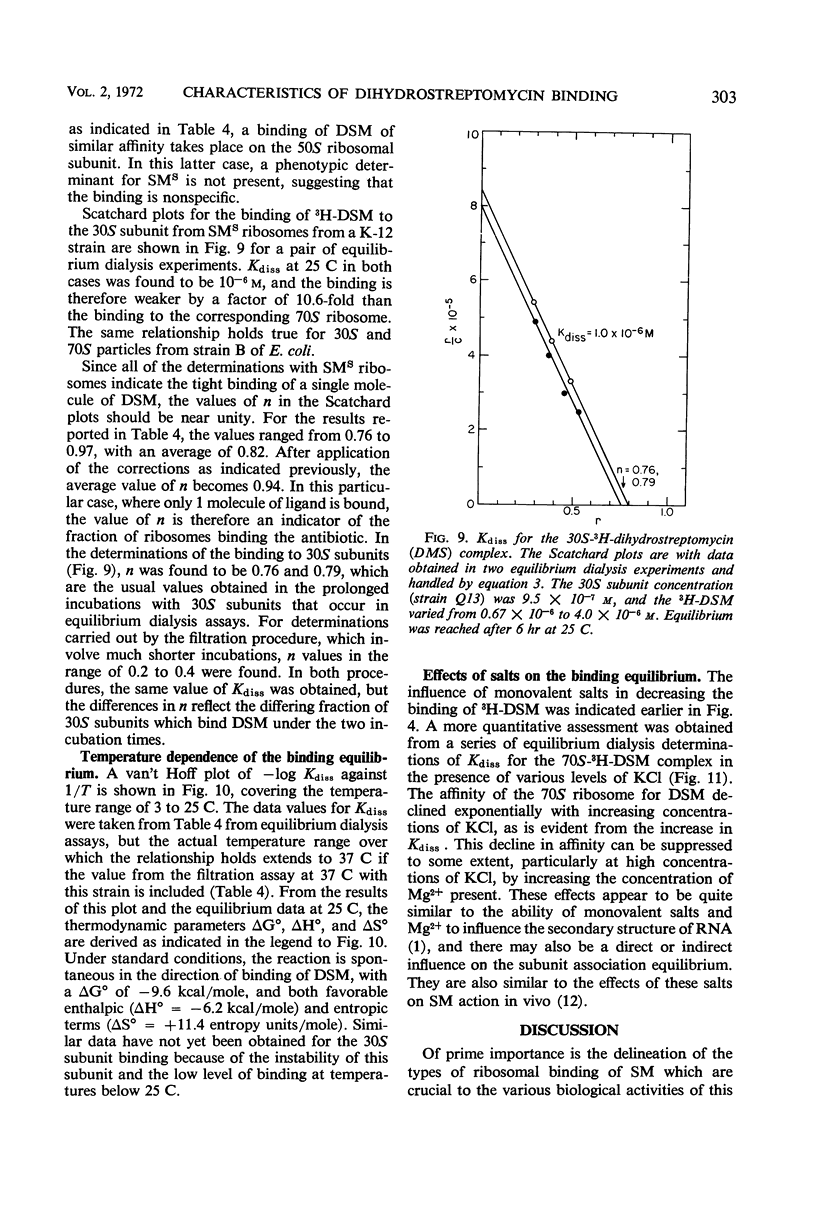
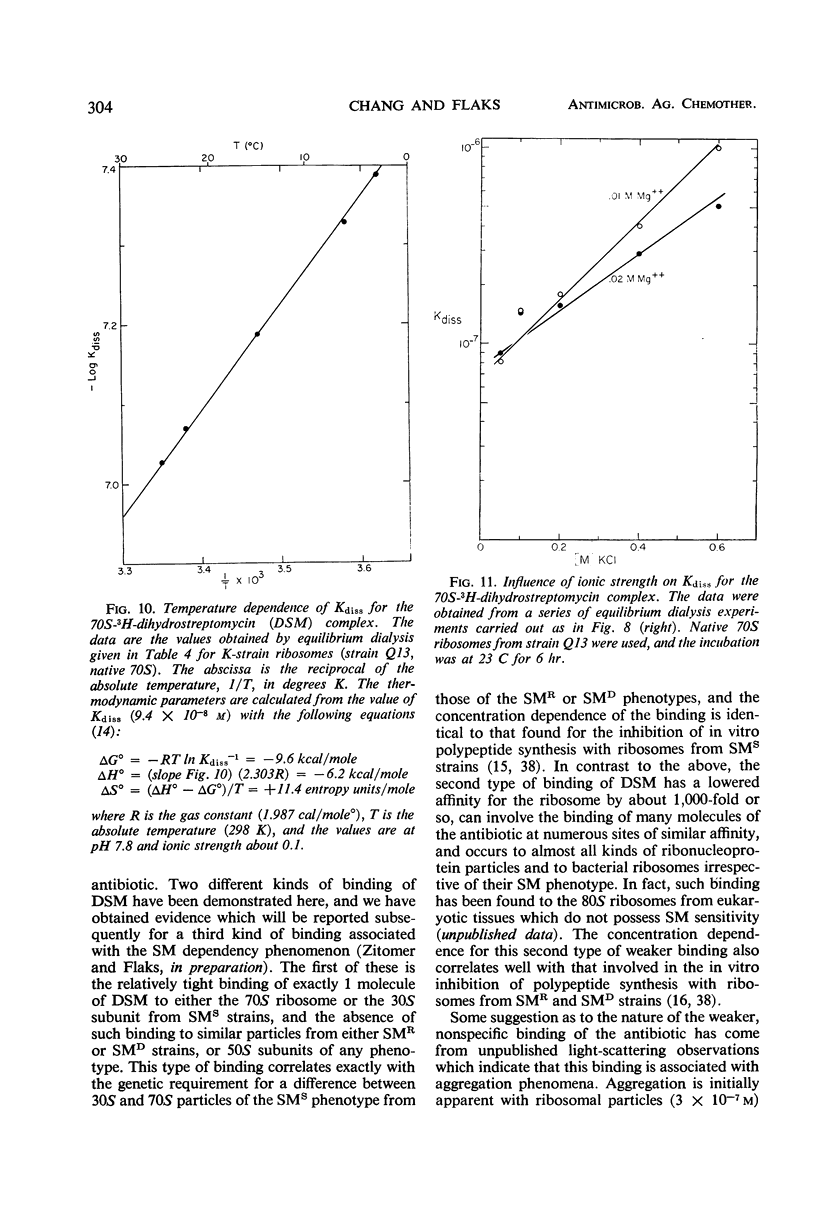



Selected References
These references are in PubMed. This may not be the complete list of references from this article.
- BROCK T. D. ACTION OF STREPTOMYCIN AND RELATED ANTIBIOTICS. Fed Proc. 1964 Sep-Oct;23:965–975. [PubMed] [Google Scholar]
- Bollen A., Helser T., Yamada T., Davies J. Altered ribosomes in antibiotic-resistant mutants of E. coli. Cold Spring Harb Symp Quant Biol. 1969;34:95–100. doi: 10.1101/sqb.1969.034.01.015. [DOI] [PubMed] [Google Scholar]
- COX E. C., WHITE J. R., FLAKS J. G. STREPTOMYCIN ACTION AND THE RIBOSOME. Proc Natl Acad Sci U S A. 1964 Apr;51:703–709. doi: 10.1073/pnas.51.4.703. [DOI] [PMC free article] [PubMed] [Google Scholar]
- Chang F. N., Flaks J. G. Binding of dihydrostreptomycin to Escherichia coli ribosomes: kinetics of the reaction. Antimicrob Agents Chemother. 1972 Oct;2(4):308–319. doi: 10.1128/aac.2.4.308. [DOI] [PMC free article] [PubMed] [Google Scholar]
- Choi Y. S., Carr C. W. Competitive binding of streptomycin and magnesium with Escherichia coli ribosomes. Nature. 1968 Feb 10;217(5128):556–557. doi: 10.1038/217556a0. [DOI] [PubMed] [Google Scholar]
- DAVIES J. E. STUDIES ON THE RIBOSOMES OF STREPTOMYCIN-SENSITIVE AND RESISTANT STRAINS OF ESCHERICHIA COLI. Proc Natl Acad Sci U S A. 1964 Apr;51:659–664. doi: 10.1073/pnas.51.4.659. [DOI] [PMC free article] [PubMed] [Google Scholar]
- Donovick R., Bayan A. P., Canales P., Pansy F. The Influence of Certain Substances on the Activity of Streptomycin: III. Differential Effects of Various Electrolytes on the Action of Streptomycin. J Bacteriol. 1948 Jul;56(1):125–137. [PMC free article] [PubMed] [Google Scholar]
- FLAKS J. G., COX E. C., WHITE J. R. Inhibition of polypeptide synthesis by streptomycin. Biochem Biophys Res Commun. 1962 May 11;7:385–389. doi: 10.1016/0006-291x(62)90320-0. [DOI] [PubMed] [Google Scholar]
- FLAKS J. G., COX E. C., WITTING M. L., WHITE J. R. Polypeptide synthesis with ribosomes from streptomycin-resistant and dependent E. coli. Biochem Biophys Res Commun. 1962 May 11;7:390–393. doi: 10.1016/0006-291x(62)90321-2. [DOI] [PubMed] [Google Scholar]
- Horne R. E., Jr, Pollard A. L. The Identification of Streptomycin on Paper Strip Chromatograms. J Bacteriol. 1948 Feb;55(2):231–234. doi: 10.1128/jb.55.2.231-234.1948. [DOI] [PMC free article] [PubMed] [Google Scholar]
- Kaji H., Tanaka Y. Binding of dihydrostreptomycin to ribosomal subunits. J Mol Biol. 1968 Mar 14;32(2):221–230. doi: 10.1016/0022-2836(68)90006-5. [DOI] [PubMed] [Google Scholar]
- Kurland C. G. The requirements for specific sRNA binding by ribosomes. J Mol Biol. 1966 Jun;18(1):90–108. doi: 10.1016/s0022-2836(66)80079-7. [DOI] [PubMed] [Google Scholar]
- LEBOY P. S., COX E. C., FLAKS J. G. THE CHROMOSOMAL SITE SPECIFYING A RIBOSOMAL PROTEIN IN ESCHERICHIA COLI. Proc Natl Acad Sci U S A. 1964 Dec;52:1367–1374. doi: 10.1073/pnas.52.6.1367. [DOI] [PMC free article] [PubMed] [Google Scholar]
- Lusk J. E., Williams R. J., Kennedy E. P. Magnesium and the growth of Escherichia coli. J Biol Chem. 1968 May 25;243(10):2618–2624. [PubMed] [Google Scholar]
- MONASTERO F. A colorimetric determination of streptomycin and dihydrostreptomycin. J Am Pharm Assoc Am Pharm Assoc. 1952 Jun;41(6):322–324. [PubMed] [Google Scholar]
- MOSKOWITZ M. DIFFERENCES IN PRECIPITABILITY OF NUCLEIC ACIDS WITH STREPTOMYCIN AND DIHYDROSTREPTOMYCIN. Nature. 1963 Oct 26;200:335–337. doi: 10.1038/200335a0. [DOI] [PubMed] [Google Scholar]
- NIRENBERG M. W., MATTHAEI J. H. The dependence of cell-free protein synthesis in E. coli upon naturally occurring or synthetic polyribonucleotides. Proc Natl Acad Sci U S A. 1961 Oct 15;47:1588–1602. doi: 10.1073/pnas.47.10.1588. [DOI] [PMC free article] [PubMed] [Google Scholar]
- NIRENBERG M., LEDER P. RNA CODEWORDS AND PROTEIN SYNTHESIS. THE EFFECT OF TRINUCLEOTIDES UPON THE BINDING OF SRNA TO RIBOSOMES. Science. 1964 Sep 25;145(3639):1399–1407. doi: 10.1126/science.145.3639.1399. [DOI] [PubMed] [Google Scholar]
- Ozaki M., Mizushima S., Nomura M. Identification and functional characterization of the protein controlled by the streptomycin-resistant locus in E. coli. Nature. 1969 Apr 26;222(5191):333–339. doi: 10.1038/222333a0. [DOI] [PubMed] [Google Scholar]
- Petitpas-Dewandre A., Barbason H., Verly W. G. Affinité pour la streptomycine des ribosomes d'Escherichia coli. Eur J Biochem. 1969 Jan;7(3):307–314. [PubMed] [Google Scholar]
- Reiner A. M. Isolation and mapping of polynucleotide phosphorylase mutants of Escherichia coli. J Bacteriol. 1969 Mar;97(3):1431–1436. doi: 10.1128/jb.97.3.1431-1436.1969. [DOI] [PMC free article] [PubMed] [Google Scholar]
- Riggs A. D., Suzuki H., Bourgeois S. Lac repressor-operator interaction. I. Equilibrium studies. J Mol Biol. 1970 Feb 28;48(1):67–83. doi: 10.1016/0022-2836(70)90219-6. [DOI] [PubMed] [Google Scholar]
- SPEYER J. F., LENGYEL P., BASILIO C. Ribosomal localization of streptomycin sensitivity. Proc Natl Acad Sci U S A. 1962 Apr 15;48:684–686. doi: 10.1073/pnas.48.4.684. [DOI] [PMC free article] [PubMed] [Google Scholar]
- SPYRIDES G. J. THE EFFECT OF UNIVALENT CATIONS ON THE BINDING OF SRNA TO THE TEMPLATE-RIBOSOME COMPLEX. Proc Natl Acad Sci U S A. 1964 Jun;51:1220–1226. doi: 10.1073/pnas.51.6.1220. [DOI] [PMC free article] [PubMed] [Google Scholar]
- Traub P., Nomura M. Streptomycin resistance mutation in Escherichia coli: altered ribosomal protein. Science. 1968 Apr 12;160(3824):198–199. doi: 10.1126/science.160.3824.198. [DOI] [PubMed] [Google Scholar]
- Vogel Z., Vogel T., Elson D., Zamir A. Ribosome activation and the binding of dihydrostreptomycin: effect of polynucleotides and temperature on activation. J Mol Biol. 1970 Dec 14;54(2):379–386. doi: 10.1016/0022-2836(70)90436-5. [DOI] [PubMed] [Google Scholar]
- WATSON J. D. THE SYNTHESIS OF PROTEINS UPON RIBOSOMES. Bull Soc Chim Biol (Paris) 1964;46:1399–1425. [PubMed] [Google Scholar]
- Weisblum B., Davies J. Antibiotic inhibitors of the bacterial ribosome. Bacteriol Rev. 1968 Dec;32(4 Pt 2):493–528. [PMC free article] [PubMed] [Google Scholar]
- Wolfgang R. W., Lawrence N. L. Intracellular distribution of 3H-dihydrostreptomycin in a streptomycin-dependent strain of Bacillus megaterium. J Bacteriol. 1968 Apr;95(4):1295–1299. doi: 10.1128/jb.95.4.1295-1299.1968. [DOI] [PMC free article] [PubMed] [Google Scholar]


